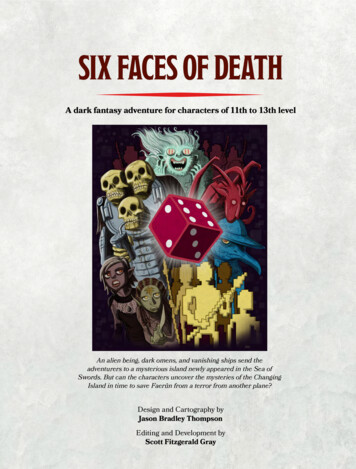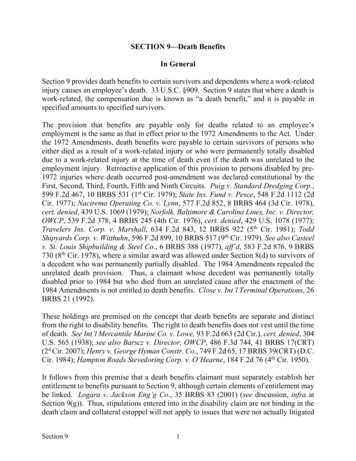
Transcription
SIX FACES OF DEATHA dark fantasy adventure for characters of 11th to 13th levelAn alien being, dark omens, and vanishing ships send theadventurers to a mysterious island newly appeared in the Sea ofSwords. But can the characters uncover the mysteries of the ChangingIsland in time to save Faerûn from a terror from another plane?Design and Cartography byJason Bradley ThompsonEditing and Development byScott Fitzgerald Gray
Beyond the Material Plane lie dimensions where godsand devils dwell, and where pure ideals are embodiedin physical form. One such place is Mechanus, the planeof ultimate law, where the geometric modrons maintainabsolute order. Another is Acheron, home to endlessbattlefields of law and evil, where reborn warriors fighteternal conflicts of metal and blood.No stars or suns appear in the skies of Acheron—onlyfloating metal cubes hurtling through the void. One ofthese was Cube 1717, designed by a mad derro architectnamed Avnas, and ruled by a powerful devil namedEarl Andromalius—a servant of the god of tyranny,Lord Bane.Cube 1717’s primary purpose was as a battle stationin Acheron’s endless wars. But it also contained a prisonand laboratory where horrifying experiments werecarried out upon court-martialed soldiers and otherdoomed souls. Some became food for horrid monsters.Others were used for weapons testing and destroyedby steel and hellfire. Once, three particularly cunningconspirators who tried to unseat Earl Andromalius werefused together into a horrible undead entity—a skull lordnamed Vargo, doomed to suffer forever in the prisonsof the cube.Unexpected VisitorNot long ago, a planar rift brought an unusualcreature to Acheron, where it was discovered by EarlAndromalius’s servants. It was a quadrone—one of thecubical warriors of the modrons, left broken in body andmind by being cut off from the order of Mechanus.When the creature was brought to Avnas, the insanederro subjected it to bizarre experiments that drove thealready unstable quadrone completely mad. Under theduress of the testing, the quadrone was corrupted bythe magic of Acheron to develop a heretofore unheard-ofpower: the ability to control other beings and make theminto creatures like itself.Exponentially growing in power and size, theArchquadrone escaped its captivity and penetratedto the engine room at the heart of Cube 1717. There,it fused its body with the cube’s engines, creating aliving brain whose first task was to instigate the deadlypixelating curse—a magical malady that transformscreatures and objects into lawful neutral cube creaturesserving the dictates of the Archquadrone.The infection spread quickly throughout Cube 1717,transforming thousands of Acheronian soldiers intocube-like mockeries of life. Earl Andromalius was killedand overthrown, and with the power of Cube 1717 attheir command, the Archquadrone’s cube-creaturessoon threatened Acheron itself.To deal with this threat, the princes and dukes ofAcheron were forced to seek the aid of the yugoloths—mercenary creatures of pure evil. The strength of theircombined forces allowed the devils and the yugolothsto besiege the cube, slaughtering its defenders. In theend, the yugoloths were forced to use the River Styxas a weapon, inundating Cube 1717 with its waters tocleanse both the memories of the dead and the cursethat infected them.Preparation and PlanningSix Faces of Death is a dark fantasy adventure featuringcountless fiends, mind control, strange physicaltransformations, and dead bodies by the thousands.Before running the scenario, you’ll want to make sure thatyour players are aware that the adventure features plentyof dark imagery and horror themes. Even then, you mightwant to downplay some of the more graphic descriptionscontained herein, according to your own sensibilities as aDM and the ages and sensitivities of your players.The adventure is also a dangerous one—and mightprove a challenge even for powerful 11th-to-13th-levelcharacters! On the bright side, though, the scenarioalso features a lot of humor that you can use to lightenthe overall dark tone. And as with many Dungeons &Dragons adventures, the difficulty level can be adjustedon the fly by giving the characters allies (the monodrone,the shadar-kai, the drow, and potentially even theoinoloth and the hydroloths), making sure they learnappropriate background information before they travel tothe mysterious island, and adjusting the efficiency of theenemies’ lair defense.Before the adventure begins, take note of whetherany characters are chaotic. This is important indetermining how resistant they are to the Archquadrone’spixelating curse.To run a particularly dangerous version of the adventure,use pregenerated characters and start the adventure with ashipwreck that leaves the party stranded on the ChangingIsland with no preparation. Can the characters uncover theisland’s many mysteries—and how long will they surviveas they try?Attempting to escape, the Archquadrone’s pixelatedservants tore open a planar rift that sent Cube 1717hurtling into the Material Plane. In a storm of fireand infernal energy, the cube appeared above theSea of Swords in western Faerûn before sinking intoits depths.Signs and SurvivorsMost of the Archquadrone’s servants died and wereunpixelated in the Styx’s purifying waters. But deepwithin the cube—at the bottom of the Sea of Swordsand still surrounded by a bubble of black Styx water—ahandful of entities survived: Avnas the derro, whosechaotic nature had temporarily protected her from thepixelation; a group of abishai priests of Tiamat whowere protected by the power of a sacred statue of theirgod; and the skull lord Vargo, who managed to escapeits imprisonment during the chaos of the battle. (SeeMordenkainen’s Tome of Foes for more on the derro, theabishai, and the skull lord.)Exploring the sunken cube’s lightless depths, Vargocame to the central engine room, where it found theArchquadrone failing and close to destruction. Withthe combined intelligence of its three heads, Vargodiscovered that it could attach those heads to parts ofthe Archquadrone’s six-sided brain to bring Cube 1717back to life—and to make itself the cube’s master. Thecontrol system Vargo created is called the Six-FaceThrone, a complex device that has allowed the skull lordto restore the cube’s internal power and gravity systems,and to bring it to the surface of the Sea of Swords.Dragon 21 Six Faces of Death2
Word of the cube’s destination reached the yugoloths,who became alarmed at it having been reactivated—anddoubly alarmed that the Acheronians might ask for theirmoney back. A strike force sent out to finish the job ofdestroying the cube ended in failure, though—and withthe capture of an oinoloth that was one of the force’sleaders. The hextons of Mechanus sent their own forcesto finish the job, but those too were overcome. Word ofthis strange new island then brought numerous sailorsand explorers into the area to investigate, but all havebeen killed or captured—with survivors forced to joinVargo’s pixelated army.The Call to AdventureWhen an important NPC vanishes in the area of themysterious island, the adventurers are inspired or calledupon to investigate. Traveling to the Changing Islandwith a mad monodrone (a survivor of the modron strikeforce) as their guide, they must find and rescue theirpixelated friend, defeat the skull lord, and end the curse.But Vargo has been waiting for just such anopportunity, hoping to entice highly intelligentadventurers to the island. By grafting the severed headsof those individuals onto its own body, the undeadhopes to become a six-headed skull lord and fullyreactivate Cube 1717, turning it into a flying, mobilebattle station with thousands of pixel soldiers under itsundead command.Can the adventurers stop the combined forces of pureevil and pure law? Or will all Faerûn become a pixelatedwasteland in thrall to the six faces of death?Characters and FactionsThe following roster summarizes the key NPCs andmonsters the characters are likely to meet during theadventure.Controllers of the CubeVargo and its servants control Cube 1717, and will dowhatever it takes to maintain the skull lord’s hold on thecube’s power.Vargo. Created from the bodies of three eviladventurers, the skull lordM Vargo has spent hundredsof years in Acheron. The personalities of the undead’sthree heads have merged over that time. It commandsall the pixelated creatures and controls three facesof the Six-Face Throne—two directly, and the thirdMonsters and MagicMost of the monsters in this adventure are taken fromMordenkainen’s Tome of Foes. When a monster nameappears in bold, it means that creature appears either inthat book or the Monster Manual. The first time a monsterappears in the adventure, the text notes if it appears inMordenkainen’s Tome of Foes. If the name appears in boldthereafter, a superscript ‘M’ indicates that the creatureappears in that book.A number of new magic items found on Cube 1717are found in the “New Magic Items” appendix at the endof the adventure. All other magic items are found in theDungeon Master’s Guide.Skull Lordthrough its servant, Sladek. Vargo seeks sufficientlyintelligent adventurers to graft onto itself, allowing it toactivate the cube’s full power and conquer Faerûn. Seearea 6.31 for more information.Sladek. A genasi mage who journeyed to the islandand became pixelated, Sladek is the NPC who inspiresthe characters’ rescue mission—but they are unawarethat he is now a pixelated mage, one of Vargo’s allies,and one of the controllers of the Six-Face Throne. Themost intelligent of the pixelated creatures transformedby the cube, Sladek now seeks to spread the pixelatingcurse to every living creature. See area 6.11B for moreinformation.Avnas. This crazed derro savantM is a mad scientist,an architect, and the only survivor of Earl Andromalius’sretinue. She serves Vargo out of a mad desire to seewhat might happen if the skull lord is able to claim thepower it seeks. See area 6.17 for more information.Bunch. A berbalang that came to the island togather the bones of the dead, Bunch is resistant to thepixelating curse because of the creature’s extraplanarnature. (The berbalang appears in Mordenkainen’sTome of Foes.) It serves Vargo in return for skulls andbones. See area 6.13 for more information.Balhannoth and Oblex. A balhannoth was broughtonto the island by a party of drow explorers as a servitormonster. Transformed into a pixelated creature, itnow serves Vargo and Sladek. An adult oblex is theproduct of one of the horrid experiments conductedDragon 21 Six Faces of Death3
in Cube 1717’s laboratory. It, too, serves the skulllord. The balhannoth and the oblex both appear inMordenkainen’s Tome of Foes. See “Face 5: BeautifulIsland” for more information.Other FactionsA number of creatures within the cube might prove to befriends or foes to the characters—or both.‘Nameless.’ Met by the characters at the start of themission, this mad monodrone has suffered damagethat has caused it to go rogue. Terrified of the “badsquare boss” inside the cube island, it picks one ofthe characters as its new boss and latches onto them,following them anywhere—but communication with thecreature is difficult. See “Mad Monodrone,” below, formore information.Fern. The only survivor of a shadar-kai expedition toexplore the island, Fern is a shadar-kai shadow dancerwith partial memory loss as a result of contact with Styxwater. She seeks to find Astilbe, a fallen friend. See area1.3 for more information on Fern, and Mordenkainen’sTome of Foes for more on the shadar-kai.Simak. This drow house captain is the only survivorof a drow expedition she led to the island, and has keptherself alive by becoming a kind of court jester to Vargo.Simak originally came to the cube hoping to activate itspower and use it as a flying war engine, but her primarygoal now is to make a safe escape. See area 6.11C formore information on Simak, and Mordenkainen’s Tomeof Foes for more on the drow.By sheer chance, a family-heirloom amulet of the Styxthat Simak wears makes her immune to the pixelatingcurse, because of the Styx water it holds inside it. Seethe “New Magic Items” appendix for more information.Abishai Priests. A group of white abishai andblack abishai are worshipers of Tiamat whose faithsaved them when Cube 1717 was nearly destroyed.Still unpixelated, they have so far avoided Vargo andare desperate to escape the island. See area 6.38 andMordenkainen’s Tome of Foes for more information onthe abishai.Malika Tahoun. This plague-ridden oinoloth wasthe leader of the yugoloth strike force sent to thematerial realm to destroy the cube. As utterly selfishas all yugoloths, it surrendered to Vargo to avoid beingkilled. Vargo is keeping Malika around as a backupcontroller for the Six-Face Throne, in the event that theskull lord can’t find a sufficient number of new heads.(It won’t graft the oinoloth’s head onto itself, becausethe creature’s plagues can infect even its undead body.)See area 6.11A for more information on Malika, andMordenkainen’s Tome of Foes for more on oinoloths.Malika wears an airtight outfit that protects it frominfection by the pixelating curse, and that also protectsthose around the oinoloth from its multitude of diseases.The mask and gloves also conceals the oinoloth’sfiendish appearance.Hydroloths. The only other survivors of the yugolothassault lurk in what the denizens of the cube call“the Styx sea”—the volume of black Styx water thatsurrounds the island. While they wait for MalikaTahoun to return, they kill any creatures that mightspread the pixelating curse. See “Invisible Guardians”and Mordenkainen’s Tome of Foes for more informationon the hydroloths.Running the AdventureSix Faces of Death is a wide-open adventure, in whichrandom chance and the players’ choices are the onlydeterminers of their progress through Cube 1717.In the first stage of the adventure, the charactersinvestigate the mysterious Changing Island. This stageplays out largely as a mystery and survival story, as thecharacters deal with deadly hydroloths, vampiric mist,the random rotation of the cube, and other threats.Figuring out how to get inside is the primary challengeof this section of the adventure—but that challenge cantake many forms, depending on which faces of the cubethe characters have a chance to explore.Once they get inside, the characters’ primarymotivation is to fight the cube’s defenders as theylearn more about its origin and purpose. Against theoverarching goal of rescuing the genasi mage Sladek,the characters might also decide that they’re obligedto destroy the cube, wanting to prevent its destructivepower from being unleashed in Faerûn.Alternatively, instead of fighting the cube’s defenders,the characters might parley with them. This couldbe an even more dangerous option, however, sincethe skull lord Vargo has diabolical plans for suitablyintelligent guests. If the characters do parley with theevil defenders of the cube, take the opportunity toroleplay the disturbing, diabolical, and potentially funnypersonalities of those defenders.Exploring the cube makes for a classic andchallenging “invade the fortress” scenario. Pixelatedcreatures can all communicate telepathically with eachother to a range of 120 feet, making it easy for themto advise other pixelated creatures or the skull lord ofthe movements and positions of intruders. If higherlevel characters are having too easy a time against thecube’s pixelated guardians, you can easily add additionalguardians or give them maximum hit points to raise thechallenge.Pixelated merregon devils and pixelated veteransserve as the cube’s guards (see the “Pixelated Guards”sidebar on the next page). Other pixelated creaturesthat can join a coordinated defense of the fortressinclude Avnas and her gray render (see area 6.17), theskull lord’s personal army of zombies and skeletonsin area 6.21, and the adult oblex and the balhannothfrom face 5.If the characters end up overwhelmed by the threatson the cube, you might want to throw them a lifeline inthe form of unexpected help. Perhaps the shadar-kai andthe drow expeditions weren’t totally wiped out, and theirforces are also currently exploring the cube to draw offits defenders or join in during a key fight.On top of all the other dangers of the cube, thecharacters must finish their quest and escape theisland before the pixelating curse transforms them intopixelated creatures. Only characters who are immune todisease can ignore this threat, and characters who canDragon 21 Six Faces of Death4
cure disease (as well as spellcasters who can cast dispelmagic or remove curse) will be kept busy.If certain characters become infected, players whoenjoy roleplaying might like the additional challengeof having infected characters become increasingly atodds with their healthy companions. Especially whena character reaches mental level 3 of the curse, let thecharacter’s player interpret their insanity rather thanyou telling them what their character is doing.The Skull Lord’s PlanAs all its heads once were in life, Vargo is intelligentand charismatic, and the skull lord won’t foolishly rushinto battle with intruders. If at all possible, it tries toapproach the characters as potential allies, assuringthem that despite its horrific undead appearance, itwants to be a resource for them. Vargo will describeitself as being trapped on the cube, and will encouragecharacters to work with it so they can all safely escape.Vargo is never without its bodyguards (see area 6.31).But if the skull lord has the chance, it presents thosebodyguards as ‘captors’, similar to the two pixelatedguards watching Malika Tahoun in area 6.11A.Vargo might make use of any or all of the followingdeceptions and half-truths when talking to the characters: Vargo didn’t cause the pixelating curse (true), anddoesn’t even know where it came from (technicallytrue). The skull lord is as ignorant as the charactersare about what’s going on (false). Vargo’s enemies are ruthless evil fiends—the yugoloths—who will also kill the characters if they findthem on the cube (true). Vargo and the party mustwork together to stop them! Vargo is a prisoner of the pixelated creatures (false),which seek to capture the characters as well (true). The cube is a damaged flying battle station, whichVargo has figured out how to reactivate (true). Onlysufficiently intelligent people can interface with thecube (true), and if the characters help the skull lordreactivate it, they can all make use of its power (false). The cube is capable of traveling from plane to plane(false). Vargo just wants to reactivate the cube so thatit can leave the Material Plane (false; Vargo wants toconquer the Material Plane). The pixelated creatures aren’t innately evil (technically true but irrelevant; the pixelated creatures’overarching goal is to spread the pixelation curse toall things). Vargo was a prisoner in the cube for hundreds ofyears, cruelly punished for trying to overthrow thecube’s devil lord (true). Thus, the skull lord wouldnever inflict such suffering on anyone else (false).If the characters engage Vargo, the skull lord attemptsto use them in one of three ways. First, it wants theiraid in defeating the hydroloths that guard the watersaround the cube, and in destroying the vampiric mistson the surface. Second, it hopes to see them becomepixelated, coming under its control as they join its armyof pixelated creatures. Third, the skull lord wantsto use characters with an Intelligence of 14or higher to attune to the Six-Face Throne,making the cube even more powerful.Pixelated GuardsTwo types of guards now serve the skull lord, and canbe found throughout the cube. Merregon devils (fromMordenkainen’s Tome of Foes) originally served as sentrieson Cube 1717, and are joined now by humanoid veteransrepresenting both the reborn souls that once fought anddied in Acheron and the adventurers and sailors that havebeen pixelated since coming to the island.Transformed by the pixelating curse, a pixelatedmerregon or pixelated veteran has its original statisticswith the following changes: Its alignment is lawful neutral. It has telepathy out to a range of 120 feet, but cancommunicate only with other pixelated creatures. It is immune to the frightened condition. It has advantage on Dexterity (Stealth) checks made tohide while in a pixelated area.If you add additional guards to the adventure, you can usepixelated merregons or pixelated veterans, as you choose.Pixelated veterans might show differences in their arms,armor, and physical features, and representatives of thedrow and the shadar-kai that came to the island might befound among them.Not all the humanoids who came to the island wereveterans, but using the veteran stat block is a usefulshortcut during play. If any pixelated veterans are returnedto their normal form, you can use other statistics for themthat are more appropriate.Pixelated MerregonDragon 21 Six Faces of Death5
Getting AheadVargo doesn’t tell the characters that they can simplyplug themselves into the Six-Face Throne to attune to it(see area 6.28), sharing the power of the cube as equals.The skull lord’s much more evil plan is to identify acharacter or NPC with an Intelligence of 14 or higher,take them to the surgery at area 6.22, get the drop onthem—then sever the character’s head for grafting ontothe skull lord’s own shoulders. Vargo’s shoulders haveroom for six heads in total, and the skull lord believesthat any newly grafted head will be at least temporarilydominated by its own preexisting personality. The extrahead will thus simply serve as an extra brain with whichto unlock more powers of the cube.From the moment Vargo and Bunch (the skull lord’sberbalang assistant, who knows of its plan) begininteracting with the characters, both try to assesstheir intelligence. Bunch uses obvious questions andintelligence tests (see area 6.13), but Vargo is moreclever. It might ply the characters with questions abouthistory or scholarly knowledge, or challenge themto games in the library (area 6.29). Vargo focuses onwizards for special attention.Once it has a fairly good idea which characters arethe smartest, the skull lord tries to separate them fromtheir companions. Other characters are allowed to roamthe fortress (but not to go out onto the surface), withVargo hoping that they eventually pixelate. Intelligentcharacters are attacked, incapacitated (the brain donormust be alive before the procedure), and dragged to thesurgery so Vargo can operate.In the interest of not railroading a character into thisfate, Vargo takes an NPC as its first target, starting withFern or Simak (if the drow’s subterfuge of idiocy fails).If the skull lord gains a fourth head, its first action is tomake that head start drinking the Styx water that oneof its own heads must drink to counter the pixelatingcurse. As a result, it regains its full skull lord statistics(see area 6.31). The skull lord also becomes visiblytaller, though this has no immediate game effect.If the new head is an NPC, Vargo automaticallysucceeds at crushing its personality and turning it intonothing more than spare memory storage for the skulllord’s dominant brains. If the new head is a character,give the character’s player a chance for the head toretain its sense of self by succeeding on two out ofthree consecutive Charisma contests against Vargo. Ifthe character succeeds, the player retains the ability tospeak, think, and occasionally control Vargo’s body bywinning Charisma contests as you determine.Only a wish spell can restore a character whosehead has been grafted onto the skull lord. As Vargoadds more heads, its personality becomes more coldand megalomaniacal—even as occasional flashes ofthe preferences and personalities of the minds it hasabsorbed come to the fore.The Super Skull LordIf Vargo gains a fifth head, the skull lord continues togrow in stature and power. In addition to becomingtaller, it statistics change as follows: Its Strength increases to 16. This increases the attackand damage modifiers of its bone staff attack by 1. Its Constitution increases to 19. This increases its hitpoints to 119 (14d8 56).If the skull lord gains a sixth head, it grows even tallerand its final statistics change as follows: Its Strength increases to 18. This increases the attackand damage modifiers of its bone staff attack by 1. Its Constitution increases to 21. This increases its hitpoints to 133 (14d8 70). Its Charisma increases to 23. This increases its spellsave DC to 19 and its spell attack bonus to 11.Missing Ships andTalking CubesThe adventure begins in a lawless port city from whichthe characters set out to the Changing Island, an houraway by ship. The assumed setting is the Sea of Swords,but you can modify the adventure to start out in anychaotic port city in Faerûn or another campaign world.Starting PointsAny of the following locations make a good start to theadventure in a Forgotten Realms campaign.Waterdeep. The greatest city of the Sword Coastfeatures numerous guilds, magical orders, mercantileenterprises, adventuring companies, and criminalorganizations that might have an interest in exploringthe Changing Island. Alternatively, you might decide tostart the adventure off in Skullport. This undergroundcity of criminals, slavers, and evil mages lies beneathWaterdeep, and is part of the great dungeon complex ofUndermountain.Athkatla. “The city of coin” is a huge port city ofhumans and halflings. With over a hundred thousandinhabitants, the city is the capital of the land of Amn,just south of the Sword Coast. Numerous powerfulfactions here might already be vying for control of theChanging Island by the time the characters set out toexplore it.Ioma. Home to fewer than a thousand people, Ioma isone of several small pirate ports in the Nelanther Isles,south of the Sea of Swords. The Nelanther pirates arecruel and lawless, and Ioma is ruled with an iron fist bya small group of Cowled Wizards—members of a secretarcane order in Amn.Port Nyanzaru. The capital of the jungle peninsulaof Chult, Port Nyanzaru is detailed in Tomb ofAnnihilation. Though not as lawless and dangerousas some of the other cities in this section, it makes anexcellent potential starting point for the adventure.Ajayib. Sometimes called the City of Wonders, Ajayibis one of the “Pearl Cities”—wealthy seaports on thecoast of the desert land of Zakhara, far to the south ofthe Sword Coast.Dragonisle. Moving the adventure to the Sea of FallenStars, inland and east of the Sword Coast, gives you theoption to use Dragonisle as a starting point. The largestof the Pirate Isles, the island is dominated by the eightthousand-foot-high mountain known as the Earthspur.Dragon 21 Six Faces of Death6
Some four thousand pirates dwell here, with most foundin the city sometimes known as Immurk’s Hold.Friends and AlliesThe setup of the adventure assumes that the charactersknow people in the port close to where the ChangingIsland has appeared. But if you’re playing the adventureas a one-shot, or if you want to give the characters anadditional NPC ally in the area, you can introduce themto Lem—a local priest of Kelemvor, Lord of the Dead.Clad in gray and lawful neutral in alignment, Lemworks to prepare dead bodies for burial by bathing themin scented holy water, thus ritually washing away theirsins. She gladly offers advice on the afterlife, undead,curses, and similar matters, and can provide potions ofhealing if the characters need them.When the characters meet with Lem, she confides tothem that a few nights earlier, she had a dark dreamwarning her of evil on the Changing Island. As such, shewarns them to be careful on their journey.The Mysterious Changing IslandWhatever port the adventurers start out in, they soonhear that a mysterious island has recently appeared inthe sea, an hour away by ship. No one has set foot onthe island and come back to tell the tale, and sailorshave given conflicting descriptions of it, causing it to benicknamed “the Changing Island.”The mysterious island was first sighted two weeksbefore. Since then, the following information hasbecome known to all folk in the port where theadventure begins. Be sure to give the characters thisinformation before they leave port. Establishing themystery of the Changing Island gives the players anumber of vital clues they need before they go there. Shortly after the island was first sighted, the seaaround it became covered by an unnaturally thickbank of fog. That fog never lifts, leaving the island in aperpetual gray twilight. The water around the island is somehow differentthan the surrounding sea. It is black and silty, offerspoor visibility, and feels unnaturally cold. No fishswim in this mysterious black water, which features aclear dividing line from the blue-green sea. The island is unnaturally square and about six hundred feet across. A number of hills and valleys can beseen rising beyond the shore, but it’s impossible tomake out details through the fog. A number of explorers have landed ships on theisland, but none have returned to tell of what theyfound. A number of the ships that approached theisland have vanished, while others have been foundfloating with their crews missing. No useful clues havebeen recovered from these derelict ships. “The Changing Island” is so-named because thosewho pass by it have given a number of conflictingdescriptions of it. Some say that the island is nothingbut bare stone, featuring terraces of sharp, angularrock in white, red, black, and bronze. Others havetalked of the island appearing as a pleasant green atollof palm trees and plant life, with sandy beaches. Most disturbingly, some witnesses have describedthe island as covered with bodies, as if the placewere the site of some terrible battle. A large numberof the fallen appeared to be armored soldiers of various races, but most were as naked as the day the
Design and Cartography by Jason Bradley Thompson Editing and Development by Scott Fitzgerald Gray An alien being, dark omens, and vanishing ships send the











